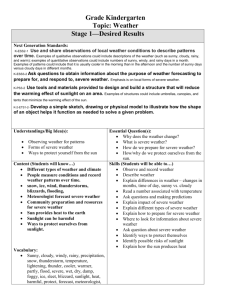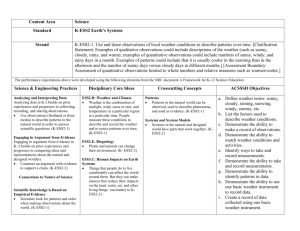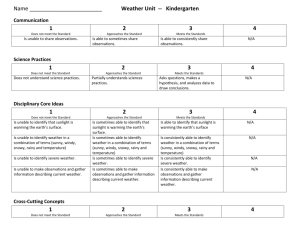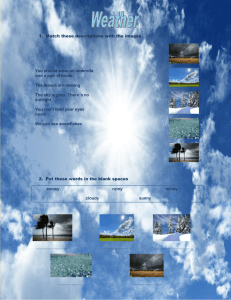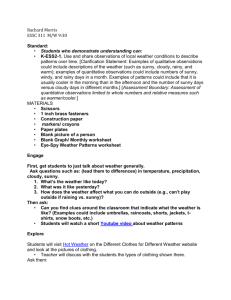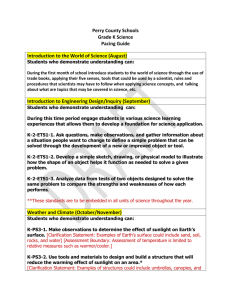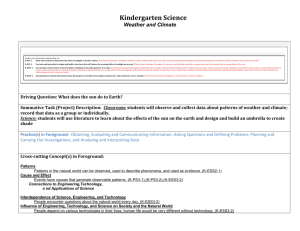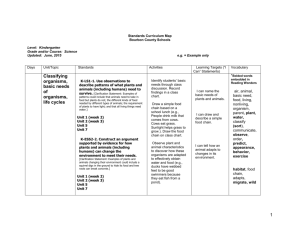Weather and Climate - the Egg Harbor Township School District
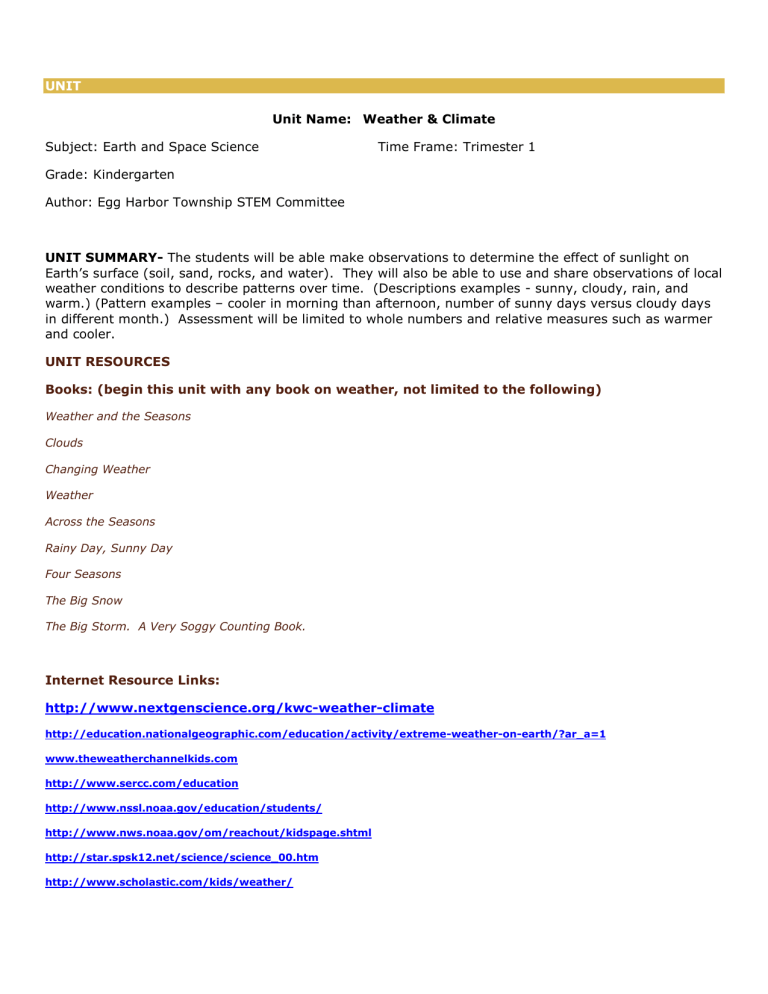
UNIT
Subject: Earth and Space Science
Unit Name: Weather & Climate
Time Frame: Trimester 1
Grade: Kindergarten
Author: Egg Harbor Township STEM Committee
UNIT SUMMARY- The students will be able make observations to determine the effect of sunlight on
Earth’s surface (soil, sand, rocks, and water). They will also be able to use and share observations of local weather conditions to describe patterns over time. (Descriptions examples - sunny, cloudy, rain, and warm.) (Pattern examples – cooler in morning than afternoon, number of sunny days versus cloudy days in different month.) Assessment will be limited to whole numbers and relative measures such as warmer and cooler.
UNIT RESOURCES
Books: (begin this unit with any book on weather, not limited to the following)
Weather and the Seasons
Clouds
Changing Weather
Weather
Across the Seasons
Rainy Day, Sunny Day
Four Seasons
The Big Snow
The Big Storm. A Very Soggy Counting Book.
Internet Resource Links: http://www.nextgenscience.org/kwc-weather-climate http://education.nationalgeographic.com/education/activity/extreme-weather-on-earth/?ar_a=1 www.theweatherchannelkids.com
http://www.sercc.com/education http://www.nssl.noaa.gov/education/students/ http://www.nws.noaa.gov/om/reachout/kidspage.shtml http://star.spsk12.net/science/science_00.htm http://www.scholastic.com/kids/weather/
STAGE ONE
GOALS AND STANDARDS
K-ESS2-1. Use and share observations of local weather conditions to describe patterns over time. [Clarification
Statement: Examples of qualitative observations could include descriptions of the weather (such as sunny, cloudy, rainy, and warm); examples of quantitative observations could include numbers of sunny, windy, and rainy days in a month. Examples of patterns could include that it is usually cooler in the morning than in the afternoon and the number of sunny days versus cloudy days in different months.] [ Assessment Boundary: Assessment of quantitative observations limited to whole numbers and relative measures such as warmer/cooler.
]
K-ESS3-2 Ask questions to obtain information about the purpose of weather forecasting to prepare for, and respond to, severe weather [Clarification Statement: Emphasis is on local forms of severe weather.].
K-PS3-1. Make observations to determine the effect of sunlight on Earth’s surface [Clarification Statement:
Examples of Earth’s surface could include sand, soil, rocks, and water] [ Assessment Boundary: Assessment of temperature is limited to relative measures such as warmer/cooler.
]
K-PS3-2. Use tools and materials to design and build a structure that will reduce the warming effect of sunlight on an area [Clarification Statement: Examples of structures could include umbrellas, canopies, and tents that minimize the warming effect of the sun.]
ENDURING UNDERSTANDINGS
Weather changes depending on the season.
Weather changes depending on the time of day.
Weather is different in different regions of the world.
Scientists can record weather across different times and areas so that they can make prediction about what kind of weather might happen next.
Earth’s processes combine to make weather.
Weather can be hazardous.
Humans cannot eliminate natural hazards, but can take steps to reduce their impacts.
ESSENTIAL QUESTION “How does weather effect your everyday life?”
KNOWLEDGE AND SKILLS
Vocabulary:
Temperature- the Measurement of how hot or cold something is.
Rain- water that falls to the earth in drops. (
Water condensed from atmospheric vapor and falling in drops.)
Snow- frozen precipitation formed by freezing water vapor
Soil- the ground or earth
Sunny- having lots of sunshine
Cloudy- having little or no sunshine
Wind- movement of air
Students will:
make observations to determine the effect of sunlight on the Earth’s surface use tools and materials to design and build a structure that will reduce warming effect of sunlight on the Earth’s surface
use and share observations of local weather conditions to describe patterns over time
ask questions to obtain information about the purpose of weather forecasting to prepare for and respond to severe weather
STAGE TWO
PERFORMANCE TASKS
Use tools and materials to design and build a structure that will reduce the warming effect of the sun on the Earth’s surface. (Build a shade structure)
Materials:
Misc. items from classroom (straws, paper, cardstock, cloth, boxes, etc.) Use your imagination
Directions:
Students will work in small groups and design a structure (large or small) that will shade the earth
OTHER EVIDENCE
Formative Assessments:
Teacher questions
Class discussions
Related Math/STEM activities
Related English Language Arts activities
STAGE THREE
LEARNING PLAN
Activities, experiences, and lessons:
September/October –Weather charting and weather differences
Track the weather each day
Begin to relate patterns when appropriate (cloudy today, rain – etc)
Incorporate Graphing (pictograph, line graph, etc.)
October/November – Shade Structure
Students will work in small groups and design a structure (large or small) that will shade the earth. This can be as simple as an umbrella or as complex as a large structure.
Common Core State Standards Connections:
ELA/Literacy –
RI.K.1 With prompting and support, ask and answer questions about key details in a text. (K-
ESS3-2)
W.K.7 Participate in shared research and writing projects (e.g., explore a number of books by a favorite author and express opinions about them). (K-PS3-1),(K-PS3-2),(K-ESS2-1)
SL.K.3 Ask and answer questions in order to seek help, get information, or clarify something that is not understood. (K-ESS3-2)
Mathematics –
MP.2 Reason abstractly and quantitatively. (K-ESS2-1)
MP.4 Model with mathematics. (K-ESS2-1),(K-ESS3-2)
K.CC Counting and Cardinality (K-ESS3-2)
K.CC.A Know number names and the count sequence. (K-ESS2-1)
K.MD.A.1 Describe measurable attributes of objects, such as length or weight. Describe several measurable attributes of a single object. (K-ESS2-1)
K.MD.A.2 Directly compare two objects with a measurable attribute in common, to see which object has “more of”/”less of” the attribute, and describe the difference. (K-PS3-1),(K-PS3-2)
K.MD.B.3 Classify objects into given categories; count the number of objects in each category and sort the categories by count. (K-ESS2-1)
